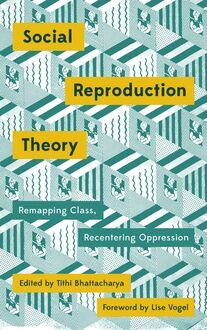Social Reproduction Theory , livre ebook
146
pages
English
Ebooks
2017
Vous pourrez modifier la taille du texte de cet ouvrage
Obtenez un accès à la bibliothèque pour le consulter en ligne En savoir plus
Découvre YouScribe en t'inscrivant gratuitement
Découvre YouScribe en t'inscrivant gratuitement
146
pages
English
Ebooks
2017
Vous pourrez modifier la taille du texte de cet ouvrage
Obtenez un accès à la bibliothèque pour le consulter en ligne En savoir plus
Publié par
Date de parution
20 octobre 2017
Nombre de lectures
2
EAN13
9781786801586
Langue
English
In this book, leading writers such as Lise Vogel, Nancy Fraser, David McNally and Susan Ferguson reveal the ways in which daily and generational reproductive labour, found in households, schools, hospitals and prisons, also sustains the drive for accumulation.
Presenting a more sophisticated alternative to intersectionality, these essays provide ideas which have important strategic implications for anti-capitalists, anti-racists and feminists attempting to find a path through the seemingly ever more complex world we live in.
Acknowledgements
Foreword by Lise Vogel
1. Introduction: Mapping Social Reproduction Theory - Tithi Bhattacharya
2. Crisis of Care? On the Social-Reproductive Contradictions of Contemporary Capitalism - Nancy Fraser
3. Without Reserves - Salar Mohandesi and Emma Teitelman
4. How Not to Skip Class: Social Reproduction of Labor and the Global Working Class - Tithi Bhattacharya
5. Intersections and Dialectics: Critical Reconstructions in Social Reproduction Theory - David McNally
6. Children, Childhood and Capitalism: A Social Reproduction Perspective - Susan Ferguson
7. Mostly Work, Little Play: Social Reproduction, Migration and Paid Domestic Work in Montreal - Carmen Teeple Hopkins
8. Pensions and Social Reproduction - Serap Saritas Oran
9. Body Politics: The Social Reproduction of Sexualities - Alan Sears
10. From Social Reproduction Feminism to the Women's Strike - Cinzia Arruzza
Notes
Index
Publié par
Date de parution
20 octobre 2017
Nombre de lectures
2
EAN13
9781786801586
Langue
English
Social Reproduction Theory
Social Reproduction Theory
Remapping Class, Recentering Oppression
Edited by Tithi Bhattacharya
Foreword by Lise Vogel
First published 2017 by Pluto Press
345 Archway Road, London N6 5AA
www.plutobooks.com
Copyright Tithi Bhattacharya 2017
Foreword Lise Vogel 2017
Front cover image: Alone we are powerless, together we are strong (1976) See Red Women s Workshop. The Posters by See Red Womens Workshop are licensed under a Creative Commons Attribution-NonCommercial-ShareALike 3.0. Unported License.
The right of the individual contributors to be identified as the authors of this work has been asserted by them in accordance with the Copyright, Designs and Patents Act 1988.
British Library Cataloguing in Publication Data A catalogue record for this book is available from the British Library
ISBN 978 0 7453 9989 8 Hardback
ISBN 978 0 7453 9988 1 Paperback
ISBN 978 1 7868 0157 9 PDF eBook
ISBN 978 1 7868 0159 3 Kindle eBook
ISBN 978 1 7868 0158 6 EPUB eBook
This book is printed on paper suitable for recycling and made from fully managed and sustained forest sources. Logging, pulping and manufacturing processes are expected to conform to the environmental standards of the country of origin.
Typeset by Stanford DTP Services, Northampton, England
Simultaneously printed in the United Kingdom and United States of America
For Shayari and Bill.
And for every woman who has been patronised while trying to change the world.
Contents
Acknowledgements
Foreword by Lise Vogel
1. Introduction: Mapping Social Reproduction Theory Tithi Bhattacharya
2. Crisis of Care? On the Social-Reproductive Contradictions of Contemporary Capitalism Nancy Fraser
3. Without Reserves Salar Mohandesi and Emma Teitelman
4. How Not to Skip Class: Social Reproduction of Labor and the Global Working Class Tithi Bhattacharya
5. Intersections and Dialectics: Critical Reconstructions in Social Reproduction Theory David McNally
6. Children, Childhood and Capitalism: A Social Reproduction Perspective Susan Ferguson
7. Mostly Work, Little Play: Social Reproduction, Migration, and Paid Domestic Work in Montreal Carmen Teeple Hopkins
8. Pensions and Social Reproduction Serap Saritas Oran
9. Body Politics: The Social Reproduction of Sexualities Alan Sears
10. From Social Reproduction Feminism to the Women s Strike Cinzia Arruzza
Notes
Index
Acknowledgements
This volume came together through ongoing conversations, explorations and engagements among the contributors. It is such collaborations that made this volume possible.
I am grateful for a grant from the College of Liberal Arts at Purdue University and generous contributions from the Founders College at York University that allowed us to host a workshop on social reproduction theory in May 2016. Kole Kilibarda ensured the success of that workshop with his unstinting hard work and thoughtful comments at sessions.
David Shulman at Pluto Press is not only one of the best but also perhaps the most patient of editors I have worked with. Sarah Grey s wonderful work proved that it makes a great difference when even the copyeditor for a book is a Social Reproduction feminist!
Thanks are due to the Historical Materialism conference, which has, over the years, allowed many of us to explore Marxist ideas without fear of heresy hunting. Many of the ideas and essays in this volume were presented and/or seeded at the conference.
The editors at Viewpoint magazine helped me clarify my own thoughts regarding class formation. I am thankful to them for letting me reproduce my essay for this volume. Thanks are also due to New Left Review (100: July-August 2016), where Nancy Fraser s essay in this volume was first published.
Several friends have read drafts of these essays and/or patiently answered my questions regarding several aspects of social reproduction theory. Colin Barker and Charlie Post have always been there to read and comment, whenever asked, usually at unreasonably short notice. Hester Eisenstein is someone I continue to learn from; her friendship and support have sustained both the volume and its editor. Nancy Holmstrom, Cindi Katz, Sara Farris, and Kevin Floyd are friends and comrades to whom I owe much. Their work provides much of the analytical scaffolding on which this volume stands. Mike McCarthy was very generous with his time and insights.
I have been talking to Gareth Dale for over two decades, sometimes about social reproduction theory and sometimes not, both to my benefit.
Also, 2017 marks 150 years from the first publication of Volume 1 of Capital , the one text to which this volume perhaps owes the greatest debt. Chris Harman helped me understand parts of that text in my twenties. I still miss being able to pick up the phone to ask Chris how to make sense of a difficult passage.
I could not write this book without Bill and I would not write it without Shayari. Every day they re-enchant the world for me.
And because of them, every day, I recapitulate to hopes about its future.
Foreword
Lise Vogel
What a pleasure it is for me to welcome this important and timely collection of essays. Social Reproduction Theory is probably the first book to draw on the past decade s resurgent interest in developing a coherent Marxist-feminist understanding of everyday life under capitalism. And who better to edit it than Tithi Bhattacharya, herself operating on the cutting edge of recent work on social reproduction theory.
The ten essays in Social Reproduction Theory address a range of questions. But one way or another, each contributor tackles the thorny problem of explaining just what social reproduction theory is. Not surprisingly, they do not always agree. Having myself had a go at this demanding task 35 years ago-in Marxism and the Oppression of Women , originally published in 1983 1 -I m sympathetic with their difficulties. At the same time, I have to recognize that the context in which this work is being developed has markedly changed, and in ways I find very exciting. First, people interested in these questions today benefit from a more developed understanding of Marxism and of history than what was available to us decades ago. And second, they appear to be connected to one another and to the nascent social movements of the twenty-first century, again in contrast to the relative isolation many of us felt in the late 1970s and after.
As proponents of social reproduction theory, the authors are wrestling with both new and old challenges. One of the oldest debates among women s liberationists concerned dualism, or dual-systems theory. By the early 1980s, the verdict was in, at least among Marxist feminists, who shared a desire to replace the dualism of earlier analyses with what they called a unitary account. To put it another way, instead of conceptualizing social reproduction as having two component aspects (for example, production of commodities and reproduction of labor power), they sought to develop an approach that would enclose both production and reproduction within a unitary framework. This is still easier said than done, as several of the essays in Social Reproduction Theory show. The pull of dual-systems thinking remains powerful, something that requires constant vigilance.
Several contributors explicitly link social reproduction theory to their understanding of intersectionality. Like social reproduction theory, intersectionality is one of several theoretical frameworks deployed over the past eighty-plus years to represent social heterogeneity as consisting of the interaction of multiple categories of social difference, for example, race, class, gender, etc. 2 To some extent the two theoretical stances have been taken as antagonistic-as a confrontation between Marxist (social reproduction theory) and non-Marxist (intersectionality) approaches. In contrast, these authors argue that it is possible to embrace social reproduction theory without discarding the strengths of intersectionality thinking, especially its ability to develop nuanced descriptive and historical accounts of various categories of social difference. This strikes me as a promising direction in which to go.
In the long run, however, I think we must jettison two dearly-held assumptions. First, the assumption that the various dimensions of difference-for example, race, class, and gender-are comparable. Second, the implication that the various categories are equal in causal weight. Willy-nilly, these two assumptions lead to an interest in identifying parallels and similarities among the categories of difference, and a downplaying of their particularities. With these assumptions gone, we can break out of the tight little circle of supposedly similar categories. Our theoretical task would then be to focus on the specificities of each dimension and to develop an understanding of how it all fits-or does not fit-together. Out of this process could come a lens, or perhaps several lenses, with which to analyze empirical data. 3
Some of the most interesting essays in Social Reproduction Theory explore the strategic or policy implications of social reproduction theorizing. Among the topics considered are: childhood; sexuality; pensions; migration; paid domestic service; and the International Women s Strike on March 8, 2017. Here we see the power of the social reproduction framework to shape our understanding of practical concerns. Or, as Bhattacharya puts it in the introduction to this book (page 19):
Social reproduction theory reveals the essence-category of capitalism, its animating force, to be human labor and not commodities. In doing so, it exposes to critical scrutiny the superficiality of what we commonly understand to be economic processes and restores to the economic process its messy, sensuous, gendered, raced, and unruly component: living human beings, capable of following orders as well as of flouting them.
Readers new to the issues covere


